GRAND RAPIDS, Minn. – In a classroom inside a defunct, historic elementary school, a few dozen "students" peppered the morning's teachers — three arts leaders — with questions. For two days, attendees of the Rural Arts and Culture Summit had seen firsthand how this northern Minnesota city incorporated the arts into its city government and its public spaces.
How, exactly, did that happen? Could they do it, too?
"It took six years. It didn't happen overnight," said Ed Zabinski, who was on the Grand Rapids City Council when it created an Arts and Culture Commission. "If you're watching from a distance, it's like watching paint dry. It's painful. But it is important, because in the process they made sure the people who had negative things to say had that opportunity.
"They checked all the boxes, touched all the bases."
In early October, about 350 people from 25 states gathered in this Mississippi River city of about 11,000 to talk about how the arts can boost small communities. Hosting the three-day, multivenue conference gave the city, better known for its paper mill, the chance to share its successes and struggles in the arts. It honored the old — KAXE, the longest-running rural public radio station in the country. It showed off the new — a handful of public art pieces scattered across the city.
In past years, Springboard for the Arts hosted this biennial conference on the campus of the University of Minnesota, Morris. But Springboard, a nonprofit that connects artists and communities, wanted to see what the event could look and feel like in a new spot, said Michele Anderson, the organization's rural program director.
Grand Rapids, with its state-of-the-art performance venue and its downtown art gallery, its high-profile indigenous arts community and its new city commission, seemed like an ideal spot, she said. The city is also honest about the area's challenges, including an economy historically dependent on mining and forestry.
"The transitions the region is facing are really significant," Anderson said. "They're showing how to look those challenges right in the face."


